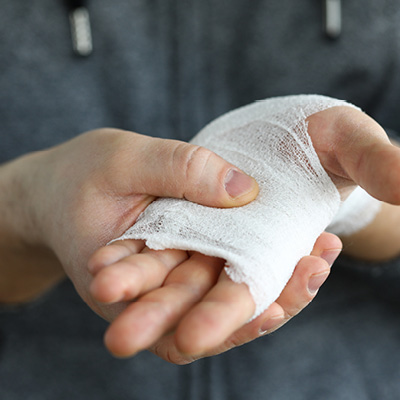Vitality eNews Sign Up
Receive the Summa Health eNewsletter for the latest health tips, advice and updates.
Do's and Dont's to safely care for cuts and scrapes at home
Posted January 17, 2022 by Mary Lareine Pastoral, M.D.

Cuts from household items, such as knives, broken glass or needles, are commonplace. All it takes is a slip of the knife during meal prep or a broken glass while cleaning up and suddenly, you’re bleeding. Now what?
Immediately apply pressure on the area with a tissue, gauze pad or clean cloth to stop any bleeding. It should stop after a few minutes, so don’t remove the gauze until you’ve applied pressure for two to three minutes. Removing the cloth too soon will break the clot that is forming.
The good news is minor cuts and scrapes can be treated safely at home by following Summa Health’s Do’s and Don’ts to preventing infection and ensuring complete healing. However, if blood spurts from the wound, or it does not stop bleeding after 10 minutes of pressure, seek medical help. You may need stitches.
Do’s to treating cuts and scrapes at home
- Do wash your hands with soap and water before tending to the cut.
- After the bleeding has stopped, do rinse the cut thoroughly with cool water.
- Do gently clean the skin around the wound with mild soap and a soft cloth after bleeding has stopped to boost the natural healing process and prevent infection.
- Do use tweezers cleaned in alcohol to remove any gravel, dirt, glass or other foreign matter that’s still in the wound.
- Do apply petroleum jelly to keep the wound moist to help the healing process.
- Do keep the cut or scrape covered with a bandage to keep it moist and prevent it from reopening for faster healing. Change the bandage daily — or sooner if it becomes dirty or wet — to keep the wound clean.
Don’ts to treating cuts and scrapes at home
- Don’t use hydrogen peroxide or iodine to clean the cut. They are harmful to the skin and can actually delay healing.
- Don’t leave a cut or scrape exposed to the air. A bandage can protect the area from rubbing against clothing and getting dirt and bacteria in it, while keeping the cut moist to heal faster.
- Don’t remove bandages quickly. Instead, remove them slowly and gently. If it feels stuck, soak it in warm water to soften the scab. Ripping it off quickly can pull off the scab with it or reopen the wound.
- Don’t scratch, pick or remove a scab. It may itch due to healing, but scratching it can rip the new skin underneath, which can delay healing or worse, leave a scar.
When to seek medical attention for cuts or scrapes
Most cuts and scrapes can be treated at home and will heal in about a week or less. However, in some cases, they may need medical attention to reduce the risk of infection and speed the healing process.
A cut needs medical attention if:
- The wound is from a human or animal bite.
- It is deep enough to see fat, muscle or bone.
- It has jagged edges or edges that gape open.
- It is a long cut or blood is spurting from it.
- It is on the face, wrist, hand or finger; and joints aren’t working.
- It is difficult to remove any dirt that is in the cut or scrape.
- The cut becomes tender, inflamed or drains a thick, creamy, grayish fluid.
- You develop a fever of more than 100.4 degrees Fahrenheit.
- The area around the cut feels numb.
- Red streaks form near the cut.
- It’s a puncture wound or deep cut and you haven't had a tetanus shot in the last 5 years.

